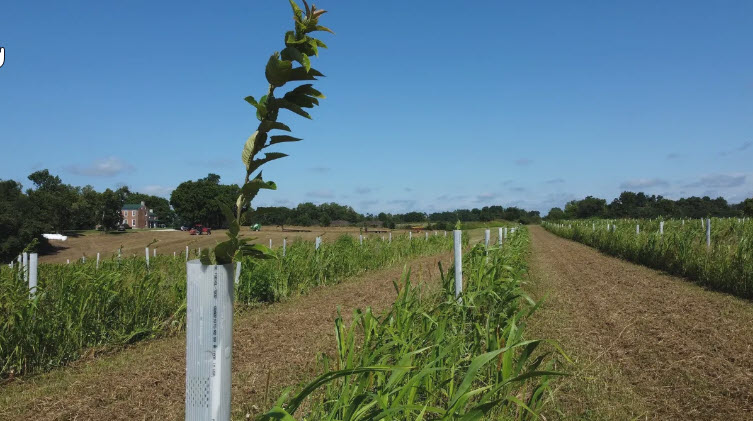
Cultivating the Future: Chestnut Farming in Kentucky – Propagate Shares Insights
Growers like United Chestnuts are based in Kentucky and provide chestnuts and trees to growers and consumers alike.
In the rolling hills of Kentucky, the past and the future coexist among the lush landscapes. This week, we share a story of passion, expertise, and sustainable innovation in the world of chestnut farming, bringing us to the latest episode of the Branching Out podcast. The remarkable Jeremy Kaufman, Chief Operating Officer and co-founder of Propagate, is featured guest, with host Melanie Jones of United Chestnuts.
Shout out to Mark Phillips of Propagate. Working in a business development capacity, Mark’s stated mission of ” Helping Scale Agroforestry as a Natural Climate Solution” caught our attention. Melanie and Mark connected on LinkedIn, which sparked this conversation with Jeremy. As we expand the chestnut and related industries, creating a community and connections is important to facilitate collaboration and conversation.
Understanding Agroforestry: Nurturing the Land
One of the highlights of my conversation with Jeremy Kaufman was his insightful explanation of agroforestry, a practice at the heart of Propagate’s mission. Agroforestry, he explains, encompasses a wide array of techniques, from integrating useful trees on farms to growing multiple crops on the same land, with one crop affecting the other in various ways. According to the USDA, agroforestry involves adding trees to support crop growth, enhancing pastures, or introducing elements like mushrooms and livestock into woodlands rotationally. It’s about making the most of the land by diversifying its use, whether it’s hay production alongside rows of trees or a complex system combining different tree types, shrubs, and livestock.
As Jeremy emphasizes, agroforestry isn’t only for the experts but should be accessible to all farmers. Propagate’s primary focus is planting trees in open acres. However, agroforestry extends to practices that support grass growth in the understory, enabling grazing, thus accommodating different farming needs and skill levels.
The Benefits of Diversification: A Bottom-Line Approach

When convincing farmers to embrace agroforestry, the conversation often starts with the bottom line. Jeremy states it’s all about demonstrating how this new approach can improve profitability compared to existing practices. Whether growing hay crops, corn, or soy, the chestnut-based systems or timber-based alternatives can enhance productivity and reduce operational costs. This method hinges on showcasing the benefits, not just environmentally but also from a pure revenue and profitability perspective, tailored to each farm’s unique needs.
Empowering Farmers: Bridging the Skills Gap
Propagate’s approach to working with farmers is remarkably flexible, catering to everyone from passive landowners to active farmers eager to embrace this novel farming approach. The level of new skills required varies depending on the system being implemented. Some skills, like working the ground and prepping for planting, are familiar to many farmers. However, new skills like marking tree rows, planting trees, and providing tree protection are areas where Propagate offers support, either in-house or through subcontracted resources. The goal is to encourage farmers to become more self-sufficient in implementing agroforestry practices, though it’s acknowledged that it’s a gradual learning process.
Ecosystem Services: Beyond the Harvest
Jeremy highlights the importance of monitoring ecosystem services beyond the harvest and the financial benefits. Ecosystem services encompass a range of elements, from carbon sequestration biodiversity improvement to reducing nitrogen and phosphorus runoff. Carbon is currently a hot topic with an active market, while biodiversity, though promising, is yet to see much revenue generation. The challenge lies in educating potential buyers about the value of these credits derived from chestnut systems and agroforestry as a whole.

A Shared Love for the Work
There’s a shared love for the work at the heart of this innovative approach to farming. Jeremy Kaufman’s favorite part of what he does is working with people like Greg Miller, individuals who have dedicated themselves to pushing the boundaries of agriculture for years. The joy, he notes, comes from visiting farms, witnessing the transformation from past practices to the present, and understanding the work that still lies ahead. The stories of resilience and progress are found in chestnuts and the broader spectrum of crops that Propagate collaborates with, reminding us that agroforestry is a journey with deep roots and boundless possibilities.
As we wrap up our conversation, it’s evident that chestnut farming in Kentucky and throughout the US is not just a business but a sustainable way of life. The dedication of growers like United Chestnuts, leaders like Jeremy Kaufman, and organizations like Propagate highlight the boundless potential of agroforestry. It’s a story of cultivating the land, embracing the future, and reaping the benefits of a more diverse and resilient farming landscape. With the promise of agroforestry and the rich history of chestnut farming in Kentucky, the future of agriculture shines bright on these fertile hills.

Get caught up on any episodes of the Branching Out podcast you may have missed. And, if you are interested in learning more about the chestnut industry, purchasing trees or nuts, or need some support, please subscribe to the weekly blog at unitedchestnuts.com, join the United Chestnuts Community group on Facebook, tune into the Branching Out podcast on YouTube, Spotify, Audible and other platforms and follow people like Jeremy Kaufman.
If you are near Kentucky and interested in various chestnut trees or chestnuts learn more at United Chestnuts.